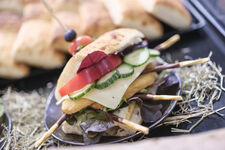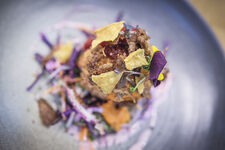Details
Comfort food 2025 – When street food grows up
Fast food was yesterday’s news – today we’re talking about comfort food with character. The next generation of street food is creative, predictable and surprisingly varied. A concept is presented, a story is told and the stage set for connection and collaboration. It lends strategic leverage to those in gastronomy who wish to succeed with emotion, regionality and global inspiration.
Trend 1: Street Food Couture – Haute cuisine in your hand
It’s back to the streets – but not as we know them: Bao Buns, Loaded Fries and Elotes (grilled Mexican street corn) are experiencing a revival, however are now more refined restyled and looking better than ever. According to the Future Menus Report from Unilever Food Solutions, this trend represents more than just a change in style – everyday food is being reclaimed by creative kitchens. “It’s nice to learn about combining the ingredients and techniques from different cuisines,” explains Giuseppe Buscicchio, Head of the Culinary Expert Group at UFS Italy.
This works particularly well with products that can be used flexibly. Take the hash browns from 11er for example, which save time on prep work and can be cooked in the combi steamer, frying pan or griddle. They form the creative basis for everything from hash brown wraps to vegetarian club sandwiches and crispy finger food.
Practical tip! Use a griddle for perfectly toasted Hash Brown Club Sandwiches served with grilled chicken, crispy bacon, cream cheese and lettuce, this is a superb signature dish for brunch menus or Meals-to-Go!.
Burgers are another good example of how well street food trends are translated into professional concepts. The vegan Smash Burger Patties from THE GREEN MOUNTAIN have been specially developed for the gastronomy sector, promoting simple preparation for an authentic BBQ taste. Out of the freezer and on to the grill, this product delivers a crispy, stackable, great-tasting burger made entirely without meat. An idea that successfully combines sustainability, taste and craftsmanship for the ultimate comfort food.
The next stage of comfort food is being cleverly demonstrated by the newly launched Wonder concept in Vienna. Located on Praterstrasse, this idea combines fast food with smart robotics – for top-quality food quickly and individually prepared with fresh ingredients. The cooking robot carries out the final preparations, ensures a high standard of quality is maintained and less food waste created. The final product is still heavily influenced by humans, however, with the team at Ramasuri have emphasised the role of the robot as “an assistant, and not a replacement.” Plant-based or rich in protein, seasonal and flexible – the dynamic menu is exactly what modern guests are looking for.
TV chef and entrepreneur Mike Süsser, owner of Gmundnerberghaus, is monitoring the street food movement with enthusiasm: “I’ve always been fascinated by the street food scene. Because I’m not just thinking as a business man, but also a guest.” Which means? Less overload, more focus, greater finesse: “Take the street food festivals, for example, the difference here is plain to see, there’s no big menu to choose from, simply two or three dishes.”
And this, he continues, is a concept relevant for the upmarket gastronomy sector: “I’d go so far as to say that today’s fine dining is often based on street food-style comfort food.”
This is an international development: “In other countries, street food has enjoyed the spotlight far longer – such as in Asia where street food is already awarded Michelin stars.”
Trend 2: Comfort Food = Emotional Food
The Future Menus Report clearly demonstrates that guests want to eat food that not only satisfies their appetite, but also makes an emotional impact. 84% of the international chefs asked confirmed that an emotional connection to food is now more important than ever. Yotam Ottolenghi sums it up nicely in his book “Ottolenghi Comfort”: feel-good food succeeds with trusted techniques – and the courage to reinterpret them. With his food, he has shown how comfort and creativity are not mutually exclusive, together they elevate food to new heights.
Ideas for the gastronomy sector:
- Take a new approach to well-known products – e.g. potato and vegetable balls with avocado cream or risotto rice with cheese crunch.
- Share stories about the dish: what are the childhood memories this particular food evokes? Which regional ingredients have been included?
Trend 3: Flexibility and sustainability
According to Statista, 68% of consumers today pay attention to where their food comes from, what ingredients are used and how healthy it is – even with fast food. The demand for vegan alternatives, nutritious snacks and sustainable packaging is increasing. Fast-food giants such as McDonald’s are responding to this with new product lines and published reports on their sustainability strategy. For those involved in gastronomy, this means that comfort food not only needs to deliver on the figures, but also feelings. Products such as the potato and vegetable snacks from 11er – plant-based, deep-frozen, combinable in a variety of ways – provide exactly this.
Serving example: Grilled garlic prawns served with potato snacks and avocado cream – simple to prepare, surprisingly tasty and appealing in its food pairing.
What does the future hold? Interactive menus and interpretation
Participation is becoming another popular approach. The Future Menus Report highlights the “Diner Designed” trend, which includes formats such as Korean BBQ, modular bowls and interactive signature stations. Guests want to be able to influence and shape their dining experience, while also being inspired – a concept confirmed by Eric Chua, Future Platform Chef Lead, UFS Southeast Asia: “Gen-Z guests prefer to have a personalised dining experience – they love flexibility and variety.”
What could that mean for your culinary concept?
- Greater selection of toppings, sides and sauces
- Live cooking stations with flambé or frying demonstrations
- QR storytelling codes on the plate
Comfort food facts, figures and trends
- 84% of those in gastronomy around the world view emotional storytelling as a key factor in successful menu design (Source: UFS)
- 68% of consumers in Germany, according to Statista, pay attention to the ingredients, regionality and sustainability of fast food
- Top 3 components for modern comfort food: storytelling, product quality and flexibility
- Practical tip: Products such as the hash browns or vegetable and potato snacks from 11er can be used as a basis for creative dishes that are easily prepared and guarantee calculability
Conclusion: From street to strategy
Comfort food is no longer simply filling the gap – but providing a creative approach with business potential. Anyone combining regional ingredients, flexible products and emotional appeal is not just creating good food but also unforgettable experiences.
Come and be inspired – at INTERGASTRA in Stuttgart from 7 to 11 February 2026. Creative product solutions, concentrated gastronomy expertise and culinary masterminds from all over Europe await you here.
zurück zur Übersicht



